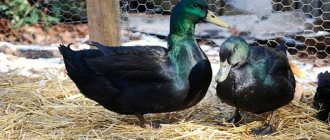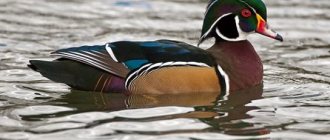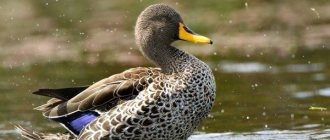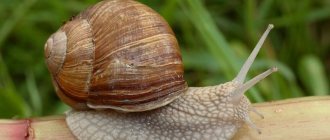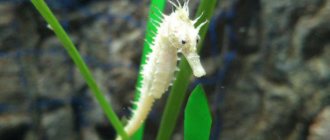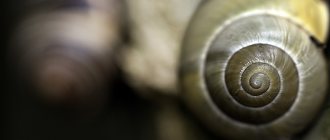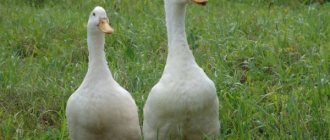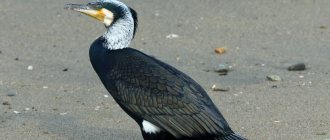In the spring, domesticated birds of different subspecies (indotted birds, musk birds, etc.) begin to prepare for breeding. They often insulate their nest with their own down, which they pluck. The birds begin to spend a lot of time in the nesting box, waiting for the eggs to lay.
To prepare a nest for incubation, no special effort is required, because ducks are excellent brood hens and a good brood can be obtained without special equipment and under normal conditions. You just need to monitor the process and note how many days the duck sits on the eggs.
Important! The nest should be arranged in a place where it is not noisy and not too bright.
The ideal option is a separate place in another pen, where young individuals will not penetrate, where no one and nothing will distract the hen. You can temporarily fence off a small area in the coop for the hen. When trying to find a secluded place, do not forget that ventilation in the duck house is very important - the air should not stagnate, and there should be no unpleasant odors.
Duck
Cardboard or wooden boxes are useful for equipping the nest. If there are none, you can build a nest yourself - put together a small box from thin boards. It is strictly not recommended to use plastic for nest equipment. Birds will not like the smell of plastic. But thin metal sheets or old barrels are quite suitable.
To ensure that the expectant mother does not stray far from the nest, it is necessary to provide her with quick access to food and drink. An artificial reservoir nearby is also needed - this can be a large basin or trough with clean water.
Attention! Having a container of water nearby where the hen will bathe is essential! The mother hen must be clean to keep her eggs clean. Careful monitoring of the purity of drinking and bathing water should continue as long as the duck hatches its eggs.
If there are 2 or more hens, it is necessary that they do not contact each other in any way. Nests should be located at a decent distance from each other, at different ends of the paddock or in different rooms. If one hen suddenly sees that another's ducklings have already hatched, she will most likely stop hatching.
Mother hen's choice
First of all, non-meat breeds of birds are suitable as hens, because when they are bred, the instinct of motherhood is suppressed. A good hen's character should be calm, non-aggressive, and not shy. She looks for a secluded place and covers it with fluff.
The most suitable breeds of birds in terms of temperament are mallards, wild ducks and Indian ducks. They are good brood hens and use them to lay other people's eggs. Among common breeds, good brood hens are Cayuga, Ukrainian gray duck, Indian runner, and Saxon.
To make sure that the hen is chosen correctly, you can conduct an experiment. Several dummy eggs are placed in the nest and the behavior of the selected female is observed. After a few days, it is necessary to replace the dummy with real ones, and if the bird continues to sit on them, then the choice of the individual has been made correctly.
When the female sits down to hatch her eggs and does not get up for 3 days, you need to carefully transfer her to food and water for 45 minutes and return her back. The procedure is repeated as necessary.
Mallard habitat
Like all ducks, the mallard lives near bodies of water:
We also recommend reading: Do not feed the ducks - they are still flying...Keeping ducks in winter. Keeping an Indian duck at home Gray duck: description of the bird, reproduction, nutrition Breeds of ducks for home breeding
- Swamps.
- Shallow lakes.
- Slow flowing rivers.
The key factor when choosing a habitat is the presence of thickets of reeds, bushes and trunks of fallen trees on the shore. All this protects birds from predators and helps them safely hatch their offspring. In open areas of reservoirs, the mallard duck is almost never found. Although the mallard duck is shy, it is common in urban water bodies. Birds fed by people behave more confidently and swim very close to feed. The mallard is a partially migratory bird. She spends the winter in regions with a milder climate:
- Mediterranean.
- Near East.
- Northern India.
- Southern China.
If the winter is mild, some ducks do not fly away, but remain on ice-free reservoirs.
Preparing for hatching
To breed pets, it is necessary to carry out preparatory work. First, a hen is selected, which must be at least 6 months old. Then the nest is prepared, covered with a thick layer of bedding, and a dummy is placed. It is located in a quiet area with good access to food and water. Extend lighting time to 16 hours with additional lighting if necessary.
Increase the amount of food and introduce necessary vitamins and minerals into the hen’s diet. Provide a bath with ash close to the nest. During laying, eggs are stored in a dry place at a temperature of 12°C. The hen is first placed on the nest in the evening so that she gets comfortable. After the hen stops getting up from her place, you can return the eggs to their place, but only in the evening, when it is dark.
How to cook at home?
There are very simple recommendations for preparation, but they are important. Therefore, there is no need to deviate from the established rules and follow them - how long to cook duck eggs:
- First, you need to rinse the eggs in cool running water, making sure to add baking soda. Or you can use laundry soap.
- Then the egg should lie in the room to warm up. This will change its taste and the protein will become a little softer.
- Boil in boiling water: hard-boiled – 15 minutes, soft-boiled – only 7, poached – 6, “in a bag” no less – 10.
Note: it has been proven that eggs are poorly digested, so it is not advisable to eat them in the evening. It is better to spare your stomach, liver and intestines.
Hatching eggs of different breeds
A domestic duck incubates eggs for 25-36 days, a wild duck for up to 40 days. Depending on the breed of ducks, the number of days of incubation varies within the specified limits.
There is no point in interfering with the hatching process, because the birds conscientiously perform their role. For a favorable outcome, the female is provided with food, drink and optimal conditions for swimming.
domestic duck
Domestic representatives hatch eggs for 26-28 days, Peking ducks - 29. This breed of birds has a poorly developed maternal instinct, and usually other ducks incubate their clutches.
Indian
This breed of birds is considered to be good brood hens. When the bird weans from the clutch, it covers the eggs on top with down. Chicken and goose eggs are often placed in the nest of this musky duck. The chicks are incubated for more than a month - 30-36 days. The maximum number of them in a nest is 12-20 pieces.
Before being placed in the nest, the Indian duck is given an increase in her daily food intake and provided with a bath of ash. During this period of her life, she needs peace, quiet and security. She selects only the best eggs and throws the rest out of the nest. Their laying begins at the end of winter. The beginning of the period can be determined by the female's restlessness and plucking of feathers for the nest.
The first clutch begins at the age of 180-270 days. Every year they bring from 60 to 120 pieces weighing 60-70 g. They lay eggs for about 3-5 months, then they go through a molting period. When the molting ends, the duck begins to lay eggs again, and there can be 2 or 3 such cycles. With the natural way of incubation, losses do not exceed 15%, in an incubator - no more than 35%.
The chicks are born hardy, healthy, and are forced to eat on the first day. The diet includes a boiled egg, milk, boiled cereals. At 2-3 days of life, they can already feed themselves on their own.
The Mulard duck breed is obtained by crossing a female Pekin duck with a male Indo duck. They are hatched both naturally and using an incubator. Eggs that have been collected for 7 days are placed in the incubator. It is better to use the natural hatching method for hatching, because... in an incubator, losses can reach 35-45%. The number of eggs in the nest is 14-15. After 10 days, they are checked for the presence of an embryo using an ovoscope.
Wild duck
The wild duck hatches its chicks without a male, with the exception of pairs formed long ago. The clutch begins to hatch after the last egg is laid, and the period lasts up to 40 days. The chicks begin to vocalize while still inside the shell a few days before hatching. They all hatch within 24 hours. They are born independent and immediately begin to run and swim. Broods of wild birds form groups for safety. At 5-10 days, the chicks can already fly.
Bashkir
The Bashkir duck, unlike other breeds, does not hatch eggs. Incubators are used for growing. To speed up egg production, she is given feed for laying hens. However, the determining factor for the start of egg laying for this species is the length of daylight hours. For every 3-4 females, 1 drake is needed for fertilization, otherwise there will be many unfertilized eggs. If the male is large, then he has 2-3 females. The eggs of this breed are the same size.
If they are small, they are not placed in the incubator. If there are ducks of the Agidel and Cherry Valley breeds, then eggs of the Bashkir duck are placed on them. You can put 10-17 pieces under it. The chicks hatch on day 28, regardless of the method of incubation.
Beijing
The Peking duck hatches its chicks for 27-29 days. The clutch depends on the size of the female and does not exceed 20. Their maternal instinct is poorly developed, so they use other breeds of ducks, chickens and geese. To awaken the female's desire to hatch eggs, dummies are used. When the female Beijing gets used to sitting in the nest, you can replace the dummy with real clutch from the incubator. Farmers do not use the nest where the duck laid her eggs for incubation, because she may abandon the nest and go look for a new one. If the duck is already accustomed to it, there is no need to move it.
Ukrainian
The breed is similar in weight and color to the Pekingese. Hatching time ranges from 24 to 30 days. At this time, it is necessary to create peace and quiet for them. The mother's instinct is well developed: she will hatch and hatch the chicks without outside help. The chicks are born strong, healthy, and nimble. After a few days, they leave the nest on their own and walk near the hen. Not all Ukrainian ducks sit on the nest.
hen duck
Hen ducks approach the process of hatching eggs differently, depending on the genetic information embedded in them. To awaken the hen's desire to breed, it is necessary to create favorable conditions. To do this, first prepare a place, select only good quality eggs. For the first few days, the duck is placed on dummies, which will allow the farmer to make sure that he has chosen the right hen.
To place a duck on a clutch, you need to choose a sunny, warm day and prepare the place. The hen incubates eggs for 23-38 days, which depends on the conditions of care.
The secret of a healing product
If you compare it with the usual chicken egg, then a duck egg is no less healthy, only it is twice as large due to its large weight and fat content. This high-calorie product (as much as 185 kcal per 100 g) is recommended by nutritionists for weight gain, restoration of immunity and strength for those who have poor health or are diagnosed with dystrophy.
It will not harm people who have heavy loads from physical labor. This product is also necessary for athletes due to the huge amount of essential amino acids and protein.
The presence of folic acid will help the body in the hematopoietic system, including the male sex to increase sperm, and is especially useful for females during pregnancy. The human skeleton and the condition of the teeth will be supported by the minerals included in the composition.
To feel great, you need selenium, which is present in eggs. Zinc improves complex brain activity and is actively involved in the growth of new skin cells. B12 helps the nervous system and normalizes carbohydrate metabolism.
So the benefits of this product are obvious. Scientists say that in addition to systems and organs, it also has a beneficial effect on mood.
Egg selection rules
To lay eggs for the hen, they must be stored for some time in a dry room at a temperature of 9-14 ° C and a humidity of 75% horizontally in a cardboard box or basket, or vertically with the blunt end up.
They are selected even, without cracks or chips, clean, and of the same size. Washing them is contraindicated, because... can lead to the washing away of the protective film that regulates the humidity inside. On the 10th day, the presence of an embryo is checked with an ovoscope. If it is absent, the egg is removed. When placing strangers, their age should not exceed 5 days.
Duck dishes on the table
You cannot cook the usual scrambled eggs from them, just like an omelet. They can only be eaten boiled. This is the feature of this product. But they are in demand in all dishes where a chicken egg should be present. This means you can safely add boiled duck whites and yolks to any salads, okroshka, stuffed mushrooms, all kinds of sandwiches, favorite sandwiches, summer soups and other dishes.
How many eggs can you put under a duck?
The number of eggs that can be placed in the nest depends on the size of the female - they must be evenly covered with her body. If the bird is small in size, then the clutch should consist of 8-10 pieces, medium - from 11 to 19 pieces, large and older than a year - up to 24. Experienced hens are trusted with a larger number. They are placed in a row. They are completely covered with bird feathers, and excess eggs are removed. The laying season is also taken into account: in cold weather, fewer specimens are placed in the nest, in summer – more. Muscovy duck is trusted up to 18 pieces, the rest - from 12 to 21 pieces.
Structure and description of appearance
Among wild ducks, the mallard is the largest. By autumn, the drake gains up to 2 kg of weight. In summer it does not exceed 1.5 kg. Females weigh up to 1.4 kg. The weight and size of the bird is affected by diet. On average, the length of a duck from beak to tail is 60 cm, and the wingspan is 26-28 cm.
The coloring of drakes and females is so different that it is difficult to believe that they belong to the same species. Females are colored in the colors of their habitat - shades of brown and red. The belly is covered with feathers of a darker color. The bird's beak is olive or dark gray in color, and its webbed feet are orange.
The mallard drake is decorated with bright plumage. The bird's head and neck are covered with dark green feathers that have an orange tint. There is a white border on the neck. The male's crop and breast are chestnut-colored. The lower part of the body has a slightly grayish color. The paws and beak of drakes are the same color as those of females.
There are also common elements in the colors of drakes and females. For example, these are the characteristic purple mirrors on the wings - they are clearly visible when ducks take off or shake their wings. The ducklings are dark yellow.
Courtship during the incubation period
When hatching chicks, the most important thing is to provide the female with peace of mind, drink and food. The duck should not be disturbed; its peace must be protected from other birds and males. Each female sitting on the nest is separated by partitions. The temperature during the cold period is maintained at least +8°C.
During hatching, the duck should go out for a walk for at least 30 minutes to bathe, eat greens, and clean feathers. The presence of a body of water nearby is especially important for the Muscovy duck, so in winter a bath with water should be provided so that the bird moistens its feathers and masonry. The eggs are moistened so that the embryo receives a sufficient amount of oxygen - a thick protective film may not allow air to pass through, so it is saturated with moisture.
The female's diet is dominated by grain crops, but overfeeding is not recommended. The hen knows how much to eat. During the first days of incubation, it can exist without food or water.
The chicks may hatch on different days, so they are removed until the entire brood has hatched. Otherwise, the hen abandons the clutch and begins to look after the ducklings.
What to do if the duck sits for a very long time
If a duck hatches its offspring longer than the allotted time, it is necessary to check the material for fertilization (presence of a chick). At night, in order to disturb the hen less, the eggs are taken from under her and examined using an ovoscope. If the egg is transparent when candled, it means it is empty. The dead embryo is indicated by a dark and motionless mass under the shell.
Eggs with chicks ready to hatch are warm. When scanned, you can see the duckling moving under the shell and hear squeaking.
It is not recommended to try to pick the shell and pull the baby out on your own; this threatens the chick’s death.
As a rule, young waterfowl hatched under a hen hatch amicably and on time.
Long haul
The flock is carefully preparing for the future flight. Unprepared young animals can simply die. Females and males store up fat, because flight conditions are not always favorable. The strengthened brood and adult birds gather in one flock and only then set off. The beginning of the flight coincides with the first drop in ambient temperature. The beginning of autumn, September or October, is the time when wild geese or flocks of ducks fly over our heads. Groups of birds migrate through the Caucasus, the countries of Asia Minor, Britain, India and Iran. Duck nomads can remain on the territory of Russia or Ukraine, but this only happens during particularly warm winter periods.
Ducks choose a place not only with warm air, but also with high-quality food. Any bodies of water are not suitable. Nature reserves or well-protected expanses of steppes and fields are an ideal territory for birds seeking refuge. In the sky, a flock looks like a key, a wedge: organized, symmetrical and with a well-coordinated connection between the birds. The size of the flock can be very small (up to a dozen) and very large (there are a hundred or even two adult individuals). American “guests” settle in European countries that have plenty of clean water, while in America there is drought and heat. Several flocks from different countries can unite into one coherent wedge. The Atlantic Ocean becomes the new home for such a diverse group of ducks.
Caring for wild ducklings
The weight of a healthy duckling ranges from 25 to 39 grams. 15 hours after the birth of the first chick, the brood is able to leave the nest. Ducklings develop much faster than other chicks. They walk well and can swim and dive. After a couple of months, their weight reaches a kilogram.
In a poultry house with wild ducklings, it is necessary to install a wooden box, lined with foam sheets on the inside. A container of hot water (volume 10 liters) is placed in it. She will serve as a heating pad. Several old blankets are laid on top of the box to prevent heat loss. A special passage is cut into the side wall so that the chicks have access to the heating pad. This simple design will keep you warm for about 8 hours. The floor of the poultry house must be warm (not lower than +28-30 degrees). Every couple of weeks this temperature is reduced slightly (to +22 and then to +16 degrees). Lighting for children is provided around the clock.
It is better not to let young animals near the water right away. It's worth waiting at least 20 days. If a fragile duckling swims in water that is cool for him, he will get sick.
Not just vegetation
Wild and domestic conditions are not the same thing, which means the birds’ diet will have to be adjusted. In their natural habitat, ducks feed on small fish, mosquito larvae and aquatic plants.
In summer, birds are mainly fed:
- zucchini;
- pumpkin;
- root vegetables;
- beet tops;
- nettle;
- clover;
- dandelions.
An important task is to provide wild birds with protein intake. To do this, add minced fish, meat trimmings, and bone meal.
Wild ducks should not be overfed; they will still not be as large as domestic ones.
Winter nutrition has its own peculiarities. Feed mixtures are made from cereals and legumes. They can be dry or soaked. Sprouted grain will make up for the lack of grass. Oats will be a source of required amino acids. It is beneficial to feed ducks corn and wheat. It is better to chop legumes first, as it is difficult for birds to swallow them whole. Also take care of the presence of algae (kelp, sea rupee, dichtilis).
In addition, wild birds must have access to natural minerals. Small pebbles, clean river sand and shells will cleanse the stomach and improve digestion. It is also useful to give the ducks chalk and salt.
Mulards
These ducks are often bred in households. The breed appeared as a result of crossing the Indochka and the Pekingese breed. Incubation material is collected for no more than one week. Hens are not large in size, so no more than one and a half dozen eggs are laid in one nest.
These ducks sit for about a month. They are distinguished by good maternal instinct and care for their offspring. Moreover, they hatch not only their own eggs, but also the products of other breeds, as well as chicken and turkey.
Diet for young animals
In order for the chicks to return home from the pond on their own, it is necessary to accustom them to evening feeding at a certain time. This way they will develop a kind of reflex.
Babies are fed every two hours in the first 5 days of life. For a one-month-old duckling - three times a day. Food for birds should be soft and half dry, since babies have not yet learned to clean their beaks from wet food. They give boiled eggs, greens, fish. All this should be convenient for the duckling to swallow, so the food is crushed. Vitamin supplements are used to support a growing body. Gradually, the young animals are accustomed to the diet of adult birds.
It is strictly forbidden to feed babies sour food. Also, do not give rye bread. It causes strong fermentation in the stomach of birds.
Keeping wild ducks at home is an interesting business. By raising your own livestock from chicks to adults, you will gain experience, and in the future this activity will become a source of stable income.
Did you like the article? If yes, please like it. Leave a comment below the text and don’t forget to share the material on social networks.

